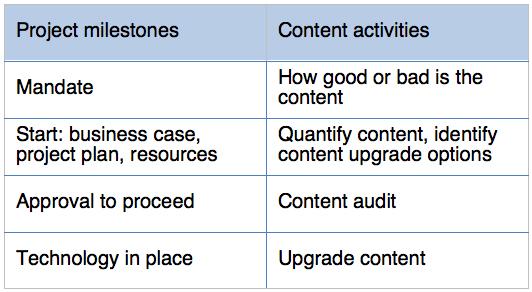Content migration in an online project
You have been advised that you will project manage an upcoming online migration project. There is a reason for it! Your current online communication has grown out of control. The content has been dumped or the owners of the material cannot be found.
It is voiced companywide that there’s a need for change, that the online presence is no longer meeting the company needs. What do you do? When should the planning and content changes start in a project?
Project conception and planning
This is an ideal time to look at what content you currently have and get a feel of the shape it is in. How good or bad is it? If your current platform has a feedback form, check the responses. Talk to users or staff and ask for their opinions. Use that feedback and work the suggestions into the business plan.
You now know the reason for changing and updating the content. However, what is the quantifiable amount of live, archived and hidden content? What do you do with it? Who owns each individual item? What governance should be or is in place?
At this point in the project it is an ideal time to consult with an online content specialist. Whether an internal or external resource, they will be able to provide a realistic assessment on how big the content component on the project is and advise on the content tasks on the project plan. From this you will be able to ascertain how long the project will take and amount of resources. This will save a huge amount of time and guesswork.
When the business owners of the project have approved the business case, you can proceed. There is an agreed delivery date and the technology is being assessed or approved. Now what to do with the content?
Decide whether content pages and documents should be:
- Kept as is
- Edited
- Changed from documents to HTML
- Deleted
- Archived
With the assistance of an online content specialist, start working with the business. Commence a content audit by identifying and documenting in a central repository owner’s names on all content (HTML, video, documents, images, etc). From this you will be able to measure the amount of content from each owner and whether they will meet your current deadlines. Also consider asking yourself, are the tasks and amount of resources on your original project plan still valid or do they need amending?
This is also a fantastic opportunity to find out who the keen and enthusiastic content owners are. Again, they can save time by being the early internal communicators on the project and communicating the project through word of mouth. All you need to do is to keep them involved and communicate regularly on the progress and wins in the project and, ask their opinions to validate decisions which impact users.
The build
Whether or not a new platform is in place, the technology is now ready to support the new content. Depending on your business and budget, the content is typically the most time consuming component on a project. Adequate resources should now be in place to commence the content upgrade. These resources now should be marking off against the content audit as individual pieces are either:
- Moved as is
- Edited
- Deleted; or
- Archived from their current state to the new version or platform.
An up to date content audit ticking off which pieces have been worked on in a central location will provide an instant snapshot on the progress on the project.
Tips:
- Start planning content before the project.
- Engage an online content specialist to focus on content tasks.
- Engage the business early in the project to assist with change and adoption.
- Keep the project in control by creating a content audit.
The author welcomes your feedback via LinkedIn or Twitter.


